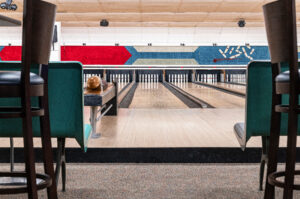By David Wilkening, Contributing Writer

Photo/Submitted
REGION – Well-known novelist Elizabeth McCracken grew up in Boston, where she was familiar with candlepin bowling. She also wrote an often-praised book about it. “These days I still candlepin bowl when I’m in New England,” she wrote last year. “I take my kids often to Sacco’s Bowl Haven in Somerville.”
McCracken, now 55 years old and a college creative writing teacher in Austin, wrote about being part of a candlepin bowling league in a Slate article ― the story’s title: “In Praise of Real Bowling.”
Many present-day participants would agree about “real” bowling. Call it “bowling light,” candlepin bowling originated in New England and is often portrayed as a family event that can include all ages. But it has a particular appeal to seniors. Many of them consider it the “real” sport of bowling.
McCracken explained that candlepin bowling is almost exclusively a New England sport (though the variation of regular big-ball bowling is also found in the Canadian Maritime Provinces). She grew up around establishments such as Sacco’s―one of the Boston area’s longtime alleys with more than 80 years of history. “We didn’t know that our bowling was a regional variation,” she said. “Even now New Englanders will say, of candlepin, ‘Oh, you mean real bowling.’”
This is ‘bowling light’
The differences between traditional and candlepin or “light bowling” are immediately obvious. The very first and possibly most obvious is the much-smaller and lighter softball-sized ball.
Executive director of the Haverhill-based International Candlepin Bowling Association (ICBA), Maria Angelotti, views it as an amazing and appropriate sport for older adults for many reasons. “The most important one is the size of the bowling balls. The small circumference and the light weight (under three pounds) is so much more manageable for them as compared to our ten pin counterparts,” she said.
The candlepin ball is also without holes, unlike the normal everyday bowling ball weighing anywhere from 10 to 16 pounds.
“Another great aspect is the fact that we leave the deadwood candlepins,” Angelotti explained. Bowlers can play angles to bounce fallen pins after still-standing ones. “That is unlike traditional bowling pins, which are cleared on the pin deck,” Angelotti noted. Regular bowlers get only two chances to down all the pins for a strike or a spare, while candlepin allows three balls. This enables the bowlers to strategize their toss and work with the angles to raise their scores.
Lower scores
The best regular bowlers might average scores over 200. But candlepin players might be happy to bowl over 100. Perfect, or games with a score of 300 are common in regular big ball bowling. But “strikes” are far rarer in the lighter version, and no one has ever rolled a perfect 300.
The highest sanctioned candlepin score is 245, achieved in 1984 in Erving and again in 2011 in Haverhill.
No wonder the lighter version is described by all as far more difficult. Candlepin bowling is “the most challenging of all indoor sports,” according to the Massachusetts Bowling Association.
A long history
Traditional ten-pin bowling began to be popular in the U.S. after the Civil War. A billiard room owner named Justin White in the 1880s trimmed the size of the pins at his Worcester hall. The pint-sized version of traditional ten-pin bowling quickly spread through New England, though it was generally confined to building basements and not with the added electronic games and dining amenities of today. In the late 1950s, a 12-lane alley with a skating rink opened in Newburyport. lt was regarded as a model for others with more elaborate options.
There were an estimated 70 million bowlers in the U.S. of all types prior to the pandemic. Virtually all bowling venues suffered as a result of the coronavirus. But owners say the revival of business today has been particularly strong with older bowlers.
Seniors as old as their 90s
Needham Bowlaway owner Zach Sundberg and others say senior leagues of bowlers in their 70s, 80s and even 90s are not only being revived but may have more participants than prior to the pandemic.
Owner of Woburn Bowladrome Mike DeRienzo also has seen an upswing of older bowlers, though families remain a staple of participants everywhere.
“Older players can have a couple of beers and pizza. They enjoy the company of being with friends,” he said. His place is said to have among the highest numbers of older participants in a Monday league.
Another longtime bowling alley in the heart of Boston that has adapted to the times is South Boston Candlepin, aka Southie Bowl. Serving craft beers, hosting corporate events, and having the ability to reserve lanes online are some of the ways the 60-year-old business has stayed relevant.
Down but not out
A senior bowler himself, Bill Ballou writing in the Telegram & Gazette in Worcester found last year that the number of bowling alleys are dwindling, but there were still 75 throughout the state. “There are far fewer bowlers now than two generations ago, but the remaining ones are passionate about the sport and welcoming to others who embrace it,” he reported.
Candlepin dying? Too dramatic, he said. But it is definitely shrinking. “The future seems to be in places like Apex in Marlboro and Wamesit Lanes in Tewksbury, massive multipurpose complexes where candlepin bowling is just one entertainment option.”
“Bowling in general has struggled these past few years,” admitted ICBA’s Angelotti. “Many of our centers have added restaurants, game rooms and bars to their footprints to bring in open bowling customers.”
Not so much with candlepins. Players seem more interested in a purer form.
“Our sport is so unique and challenging that it stands on its own, especially for the seniors. They aren’t interested in game rooms, restaurants, laser tag or all the other (usual) draws. They simply want to bowl, and maybe play Keno,” she said.












